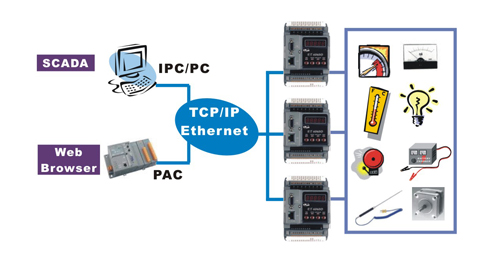
- #Modbus tcp spec serial#
- #Modbus tcp spec code#
Read-only read-write read-only read-writeĭiscrete Input Discrete output/Coil Input Register (Holding) Register Single bit single bit 16-bit word 16-bit word Table 1 contains the basic Modbus data types defined by the specification.ĭiscrete Input Discrete Output (Coils) Input Registers Holding Registers (Registers) The basic public functions have been developed for exchanging data typical for the field of automation.

Assigned codes and descriptions can be found in the specification.
#Modbus tcp spec code#
The primary identification of an exception response is the error code (function code + 128), which is further specified by the exception code. In certain cases, the response from a slave will be an exception. the Exception Response PDU The specification further documents defined and assigned public functions. what it is good for), it's parameters and return values (including possible exceptions). The documentation for a function consists of: 1.
Reserved These are currently used by some companies for legacy products and are not available for public use (these are not discussed any further in the specification). The specification defines the code ranges 65-72 and 100-110 for user-defined functions. User-Defined Are available for user-defined functions, thus their codes might not be unique. These are validated by the community and a conformance test exists. Public Are guaranteed to be unique and specify well defined functions that are publicly documented. Class 0, Class 1, Class 2), the newly released specification (from see Knowledge Base Index (./kbase/index.html) ) defines categories of function codes: While the first published version of the specification defined different classes of functions (e.g. These are in the range 1-127 (decimal), as 129(1+128)- 255(127+128) represents the range of error codes. The specification defines a certain number of functions, each of which is assigned a specific function code. Table 3: Figure 3: Modbus Protocol Data Units (PDU) 
and a code specifying the exception (Exception Code, 1 byte) Figure 3 presents a visualization of these packages. the function code corresponding to the request + 0x80 (128), (Error Code, 1 byte) 2.
Exception Response PDU, consisting of: 1. and response specific data (Response Data, varying number of bytes) the function code corresponding to the request (Function Code, 1 byte) 2. and function specific data (Function Data, varying number of bytes) a code specifying a function (Function Code, 1 byte) 2. The protocol specification defines three types of PDU's: Table 2: Figure 2: Modbus Transaction The stateless communication is based on a simple package, that is called Protocol Data Unit (PDU). the Slave is a Server A transaction and it's context is visualized in Figure 2. To prevent confusion, the following directed relations describe Master-Slave in terms of the Client-Server paradigm: In the field where this protocol is usually applied, there exists a concept that is one of the possible schemas governing the lower level communication behavior on a network using a shared signal cable: Master-Slave. 
much like HTTP), based on transactions, which consist of a request (issued by the client) and a response (issued by the server). Table 1: Figure 1: ISO/OSI Context At this level Modbus is a stateless client-server protocol (e.g.
#Modbus tcp spec serial#
It presents a basic protocol description and discusses the serial and the TCP based implementations.īasically Modbus is an application layer protocol (see Figure 1) for communication between devices, mainly to exchange data typical for the field of automation. This document introduces the reader to the Modbus protocol. Modbus Implementations.4Ĭritical Evaluation of the Specification(s).6

3 Serial Modbus Implementations.4 IP based Modbus Implementations. Understanding the Modbus )Ībout.2 Modbus Protocol Basics.








 0 kommentar(er)
0 kommentar(er)
